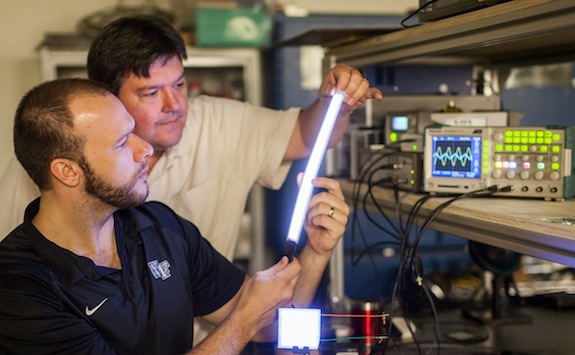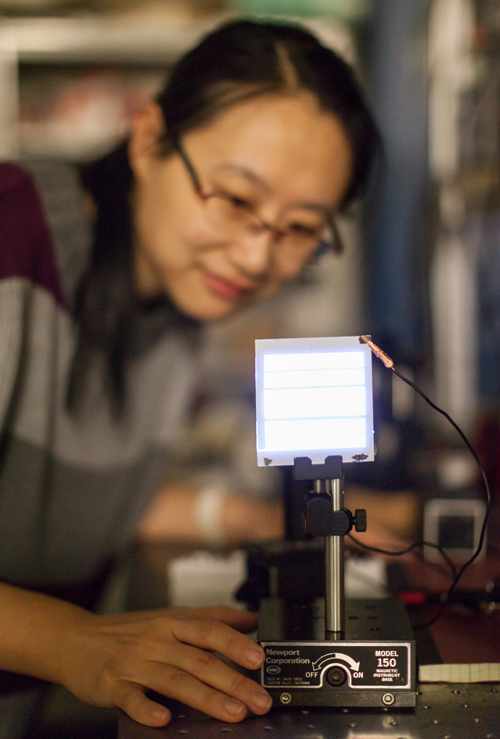Sick of Fluorescents? New Technology Provides Flicker-Free Light
A new advance in lighting could soon bring a silent, consistent glow that’s easy on the eyes to an office near you
![]()

A new plastic-based lighting technology produces a consistent, silent white glow that’s pleasing on the eyes. Image by Ken Bennett, Wake Forest University photographer
Chances are, sometime today, you sat in an office, classroom or workplace lit by constantly humming fluorescent light bulbs. Although they’ve long been favored by those who design buildings for their energy efficiency, fluorescent tubes are widely detested by those who sit in them because of the fact that they hum, flicker at a just-barely-perceptible rate, and emit an unsettling green tinge.
Now, while we search for replacements for the now-phased-out incandescent bulb, a group of researchers from Wake Forest University offers a potential solution. As they described yesterday in an article published in the journal Organic Electronics, they’ve harnessed a technology called field-induced polymer electroluminescence (FIPEL) to produce a constant, energy-efficient, soft white light.
“People often complain that fluorescent lights bother their eyes, and the hum from the fluorescent tubes irritates anyone sitting at a desk underneath them,” said David Carroll, one of the scientists leading the team. “The new lights we have created can cure both of those problems and more.”

The technology can be used to produce lights in a variety of shapes and sizes, from large panels to small, household-sized squares. Image by Ken Bennett, Wake Forest University photographer
The technology converts an electrical charge into light with three layers of a white-emitting plastic polymer matrix that incorporates trace amounts of nanomaterials that glow when stimulated. The team says the consistent white light that is produced has a similar spectrum to natural sunlight, so it’s also more pleasant to the human eye than the blue-tinged glow of LED lights. Researchers have been working to make FIPEL-based bulbs viable for some time, but this is the first instance of a practical use of the technology to produce light.
“ have a bluish, harsh tint to them, ” Carroll told BBC News, “it is not really accommodating to the human eye; people complain of headaches and the reason is the spectral content of that light doesn’t match the Sun—our device can match the solar spectrum perfectly.”
His team also claims a number of other advantages for FIPEL. It’s more than twice as energy efficient as compact fluorescent (CFL) bulbs and roughly as efficient as LEDs. Unlike both of these bulbs, though, the bendable FIPEL technology is shatter-proof, so there’s no risk of contaminating a home or office with hazardous chemicals. It’s also extremely long-lasting: the researchers say a single FIPEL bulb may work effectively for up to a decade. Office workers will be especially excited to hear that it’s perfectly silent while in operation.
“What we’ve found is a way of creating light rather than heat,” he told BBC, explaining how his team’s devices achieve such a high level of energy efficiency. “Our devices contain no mercury, they contain no caustic chemicals and they don’t break as they are not made of glass.”
Additionally, the new technology can be manufactured in a variety of sizes and shapes. It could be incorporated into small bulbs with Edison sockets to fit light fixtures in homes, as well as large sheets to replace florescent tubes in offices. Although the team has focused on using it to make white light thus far, it can be altered to produce different colors, so it could eventually prove useful in large displays, such as public advertisements and storefronts.
The team says they’re currently partnering with a company to produce FIPEL-based bulbs on a broad scale and that the bulbs could be available to consumers sometime in 2013.
/https://tf-cmsv2-smithsonianmag-media.s3.amazonaws.com/accounts/headshot/joseph-stromberg-240.jpg)
/https://tf-cmsv2-smithsonianmag-media.s3.amazonaws.com/accounts/headshot/joseph-stromberg-240.jpg)